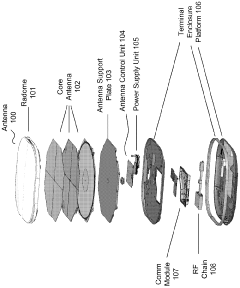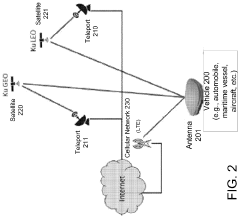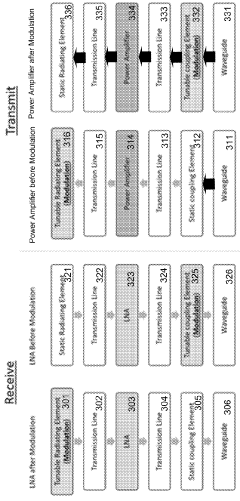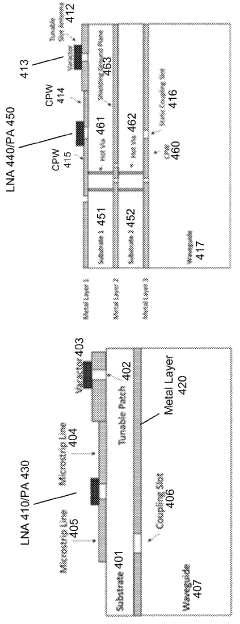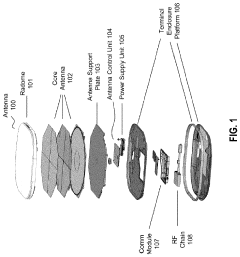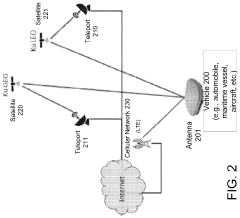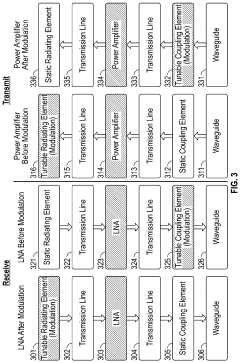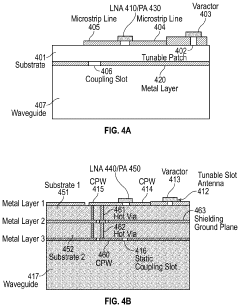How Metasurface Antennas Enhance Signal Quality in IoT
SEP 25, 20259 MIN READ
Generate Your Research Report Instantly with AI Agent
Patsnap Eureka helps you evaluate technical feasibility & market potential.
Metasurface Antenna Technology Evolution and Objectives
Metasurface antennas represent a revolutionary advancement in electromagnetic wave manipulation technology, evolving from traditional antenna designs to highly sophisticated engineered surfaces capable of unprecedented signal control. The journey began in the early 2000s with theoretical explorations of metamaterials, which demonstrated unusual electromagnetic properties not found in nature. By 2010, researchers had successfully transitioned from three-dimensional metamaterial structures to two-dimensional metasurfaces, marking a critical turning point in antenna miniaturization and functionality.
The evolution accelerated between 2015-2020, when practical metasurface antennas emerged with capabilities for beam steering, polarization control, and frequency selectivity. This period saw the transition from academic research to early commercial prototypes, particularly in specialized communication systems. The technology's trajectory has been characterized by increasing integration density, improved manufacturing techniques, and enhanced computational design methods that optimize performance for specific applications.
Current metasurface antenna technology aims to address several critical objectives in IoT environments. Primary among these is signal quality enhancement through intelligent beam forming and interference mitigation, which directly impacts device connectivity reliability in dense deployment scenarios. Another key objective is miniaturization without performance compromise, enabling integration into space-constrained IoT devices while maintaining or improving signal characteristics.
Energy efficiency represents another crucial goal, as metasurface antennas can potentially reduce power requirements for signal transmission and reception, extending battery life in IoT devices. Adaptability to dynamic environments through reconfigurable designs constitutes a forward-looking objective, allowing antennas to respond to changing signal conditions and network demands in real-time.
Cost-effective manufacturing at scale remains a significant challenge and objective, as widespread IoT adoption requires economically viable production methods for these sophisticated components. Researchers are exploring novel fabrication techniques including printed electronics and self-assembly processes to address this constraint.
The convergence of metasurface antenna technology with artificial intelligence and machine learning algorithms represents an emerging frontier, with objectives focused on creating self-optimizing antenna systems that can learn from their environment and adapt accordingly. This intelligent antenna paradigm aims to deliver unprecedented signal quality through autonomous operation in complex IoT ecosystems.
Looking forward, the technology roadmap includes objectives for multi-functional integration, where metasurface antennas simultaneously serve as sensors, energy harvesters, and communication interfaces, maximizing component utility in IoT applications while minimizing device footprint and complexity.
The evolution accelerated between 2015-2020, when practical metasurface antennas emerged with capabilities for beam steering, polarization control, and frequency selectivity. This period saw the transition from academic research to early commercial prototypes, particularly in specialized communication systems. The technology's trajectory has been characterized by increasing integration density, improved manufacturing techniques, and enhanced computational design methods that optimize performance for specific applications.
Current metasurface antenna technology aims to address several critical objectives in IoT environments. Primary among these is signal quality enhancement through intelligent beam forming and interference mitigation, which directly impacts device connectivity reliability in dense deployment scenarios. Another key objective is miniaturization without performance compromise, enabling integration into space-constrained IoT devices while maintaining or improving signal characteristics.
Energy efficiency represents another crucial goal, as metasurface antennas can potentially reduce power requirements for signal transmission and reception, extending battery life in IoT devices. Adaptability to dynamic environments through reconfigurable designs constitutes a forward-looking objective, allowing antennas to respond to changing signal conditions and network demands in real-time.
Cost-effective manufacturing at scale remains a significant challenge and objective, as widespread IoT adoption requires economically viable production methods for these sophisticated components. Researchers are exploring novel fabrication techniques including printed electronics and self-assembly processes to address this constraint.
The convergence of metasurface antenna technology with artificial intelligence and machine learning algorithms represents an emerging frontier, with objectives focused on creating self-optimizing antenna systems that can learn from their environment and adapt accordingly. This intelligent antenna paradigm aims to deliver unprecedented signal quality through autonomous operation in complex IoT ecosystems.
Looking forward, the technology roadmap includes objectives for multi-functional integration, where metasurface antennas simultaneously serve as sensors, energy harvesters, and communication interfaces, maximizing component utility in IoT applications while minimizing device footprint and complexity.
IoT Signal Quality Market Requirements Analysis
The IoT market is experiencing unprecedented growth, with the number of connected devices projected to reach 30.9 billion by 2025. This explosive expansion creates significant demands for enhanced signal quality across diverse deployment environments. Current IoT applications face substantial challenges in maintaining reliable connectivity, particularly in dense urban settings, industrial environments, and remote locations where signal interference, multipath fading, and physical obstructions are common.
Market research indicates that approximately 68% of IoT project failures can be attributed to connectivity issues, highlighting the critical importance of signal quality in successful deployments. Enterprise customers consistently rank signal reliability as their top concern when implementing IoT solutions, followed by power efficiency and data throughput capabilities.
The healthcare sector demonstrates particularly stringent requirements, demanding 99.999% uptime for critical monitoring devices and medical implants. Similarly, industrial IoT applications require robust signals capable of penetrating metal structures and operating reliably in electromagnetically noisy environments, with tolerance for signal degradation below 2% in mission-critical applications.
Consumer IoT markets show increasing sensitivity to device form factors, with 73% of consumers preferring compact devices that don't compromise on connectivity performance. This creates market pressure for antenna solutions that deliver superior performance while maintaining minimal footprint and aesthetic appeal.
Energy efficiency represents another crucial market requirement, as 82% of IoT deployments involve battery-powered devices where power consumption directly impacts operational lifespan. The market increasingly demands antenna technologies that can maintain high signal quality while minimizing power draw, with target improvements of 30-40% over conventional antenna designs.
Geographic variations in signal quality requirements are substantial, with urban deployments prioritizing interference mitigation and rural applications emphasizing range extension. Emerging markets show particular interest in cost-effective solutions that can operate reliably in infrastructure-limited environments.
Regulatory compliance adds another dimension to market requirements, with regional variations in frequency allocations and transmission power limitations. Solutions must be adaptable to these regulatory frameworks while maintaining consistent performance across global deployments.
The financial implications of signal quality are significant, with enterprises willing to invest 15-20% premium on hardware that demonstrably improves connectivity reliability. This price sensitivity varies by sector, with critical infrastructure and healthcare showing higher willingness to pay for performance guarantees compared to consumer applications.
Market research indicates that approximately 68% of IoT project failures can be attributed to connectivity issues, highlighting the critical importance of signal quality in successful deployments. Enterprise customers consistently rank signal reliability as their top concern when implementing IoT solutions, followed by power efficiency and data throughput capabilities.
The healthcare sector demonstrates particularly stringent requirements, demanding 99.999% uptime for critical monitoring devices and medical implants. Similarly, industrial IoT applications require robust signals capable of penetrating metal structures and operating reliably in electromagnetically noisy environments, with tolerance for signal degradation below 2% in mission-critical applications.
Consumer IoT markets show increasing sensitivity to device form factors, with 73% of consumers preferring compact devices that don't compromise on connectivity performance. This creates market pressure for antenna solutions that deliver superior performance while maintaining minimal footprint and aesthetic appeal.
Energy efficiency represents another crucial market requirement, as 82% of IoT deployments involve battery-powered devices where power consumption directly impacts operational lifespan. The market increasingly demands antenna technologies that can maintain high signal quality while minimizing power draw, with target improvements of 30-40% over conventional antenna designs.
Geographic variations in signal quality requirements are substantial, with urban deployments prioritizing interference mitigation and rural applications emphasizing range extension. Emerging markets show particular interest in cost-effective solutions that can operate reliably in infrastructure-limited environments.
Regulatory compliance adds another dimension to market requirements, with regional variations in frequency allocations and transmission power limitations. Solutions must be adaptable to these regulatory frameworks while maintaining consistent performance across global deployments.
The financial implications of signal quality are significant, with enterprises willing to invest 15-20% premium on hardware that demonstrably improves connectivity reliability. This price sensitivity varies by sector, with critical infrastructure and healthcare showing higher willingness to pay for performance guarantees compared to consumer applications.
Current Metasurface Antenna Capabilities and Limitations
Metasurface antennas represent a significant advancement in antenna technology, offering unique capabilities that conventional antennas cannot match. These antennas utilize artificially engineered surfaces with sub-wavelength structures to manipulate electromagnetic waves with unprecedented control. Currently, metasurface antennas can achieve beam steering, polarization control, and frequency selectivity through passive, active, or hybrid configurations, enabling more efficient signal transmission and reception in IoT environments.
The miniaturization capability of metasurface antennas stands as one of their most valuable attributes for IoT applications. These antennas can be designed with significantly reduced form factors while maintaining or even improving performance metrics compared to traditional antennas. This characteristic is particularly beneficial for space-constrained IoT devices where conventional antenna integration poses significant challenges.
In terms of signal quality enhancement, current metasurface antennas demonstrate impressive capabilities in mitigating multipath interference—a common issue in dense IoT deployments. By precisely controlling the radiation pattern, these antennas can focus energy in desired directions while suppressing unwanted reflections, resulting in improved signal-to-noise ratios and reduced bit error rates in complex propagation environments.
Despite these advantages, metasurface antennas face several limitations. Bandwidth constraints remain a significant challenge, as many designs operate effectively only within narrow frequency ranges. This limitation restricts their application in wideband IoT systems that require operation across multiple frequency bands or protocols simultaneously.
Manufacturing complexity presents another substantial hurdle. The fabrication of metasurface antennas often requires sophisticated processes to achieve the precise sub-wavelength structures necessary for proper functionality. This complexity translates to higher production costs compared to conventional antennas, limiting widespread adoption in cost-sensitive IoT applications.
Power consumption issues also affect active metasurface implementations. While passive metasurfaces require no power, active designs that enable dynamic reconfiguration typically demand additional power for control circuitry and tuning elements. This power requirement can be problematic for battery-operated IoT devices where energy efficiency is paramount.
Environmental sensitivity represents another limitation, as the performance of metasurface antennas can degrade under varying environmental conditions. Changes in temperature, humidity, or mechanical stress may alter the electromagnetic properties of the metasurface structures, potentially affecting reliability in real-world IoT deployments.
Integration challenges with existing IoT hardware and communication protocols further complicate implementation. Many current IoT systems are designed around conventional antenna technologies, requiring significant redesign efforts to accommodate metasurface antennas and fully leverage their capabilities.
The miniaturization capability of metasurface antennas stands as one of their most valuable attributes for IoT applications. These antennas can be designed with significantly reduced form factors while maintaining or even improving performance metrics compared to traditional antennas. This characteristic is particularly beneficial for space-constrained IoT devices where conventional antenna integration poses significant challenges.
In terms of signal quality enhancement, current metasurface antennas demonstrate impressive capabilities in mitigating multipath interference—a common issue in dense IoT deployments. By precisely controlling the radiation pattern, these antennas can focus energy in desired directions while suppressing unwanted reflections, resulting in improved signal-to-noise ratios and reduced bit error rates in complex propagation environments.
Despite these advantages, metasurface antennas face several limitations. Bandwidth constraints remain a significant challenge, as many designs operate effectively only within narrow frequency ranges. This limitation restricts their application in wideband IoT systems that require operation across multiple frequency bands or protocols simultaneously.
Manufacturing complexity presents another substantial hurdle. The fabrication of metasurface antennas often requires sophisticated processes to achieve the precise sub-wavelength structures necessary for proper functionality. This complexity translates to higher production costs compared to conventional antennas, limiting widespread adoption in cost-sensitive IoT applications.
Power consumption issues also affect active metasurface implementations. While passive metasurfaces require no power, active designs that enable dynamic reconfiguration typically demand additional power for control circuitry and tuning elements. This power requirement can be problematic for battery-operated IoT devices where energy efficiency is paramount.
Environmental sensitivity represents another limitation, as the performance of metasurface antennas can degrade under varying environmental conditions. Changes in temperature, humidity, or mechanical stress may alter the electromagnetic properties of the metasurface structures, potentially affecting reliability in real-world IoT deployments.
Integration challenges with existing IoT hardware and communication protocols further complicate implementation. Many current IoT systems are designed around conventional antenna technologies, requiring significant redesign efforts to accommodate metasurface antennas and fully leverage their capabilities.
Existing Metasurface Solutions for IoT Signal Enhancement
01 Metasurface design for signal quality enhancement
Metasurface antennas can be designed with specific patterns and structures to enhance signal quality. These designs manipulate electromagnetic waves through engineered surfaces that control reflection, refraction, and diffraction properties. By optimizing the metasurface geometry and arrangement, signal-to-noise ratio can be improved, interference reduced, and overall transmission quality enhanced across various frequency bands.- Metasurface design for improved signal quality: Metasurface antennas can be designed with specific patterns and structures to enhance signal quality. These designs manipulate electromagnetic waves through engineered surfaces with sub-wavelength features, allowing for precise control of wave propagation, phase, and amplitude. Advanced metasurface designs can reduce signal distortion, minimize interference, and improve overall signal integrity in wireless communication systems.
- Beamforming and directivity enhancement techniques: Metasurface antennas can implement sophisticated beamforming techniques to improve signal quality by focusing energy in desired directions. These antennas use reconfigurable elements to dynamically adjust radiation patterns, enhancing directivity and gain. By concentrating signal power toward intended receivers and minimizing radiation in unwanted directions, these techniques significantly improve signal-to-noise ratio and reduce multipath interference in challenging communication environments.
- Integration with signal processing systems: Metasurface antennas can be integrated with advanced signal processing systems to enhance signal quality. This integration allows for real-time adaptation to changing environmental conditions and interference sources. Signal processing algorithms work in conjunction with reconfigurable metasurface elements to optimize reception, filter unwanted signals, and compensate for distortion. This combined approach enables robust performance in complex electromagnetic environments and improves overall communication reliability.
- Frequency selective and wideband operation: Metasurface antennas can be designed to operate efficiently across multiple frequency bands or with frequency-selective characteristics to improve signal quality. These antennas utilize carefully engineered resonant structures to filter, enhance, or suppress specific frequency components. Wideband metasurface designs maintain consistent performance across broad frequency ranges, while frequency-selective implementations can isolate desired signals from interference, both contributing to improved signal quality in various applications.
- Miniaturization and integration for mobile applications: Metasurface antennas enable significant miniaturization while maintaining high signal quality for mobile and compact applications. These antennas leverage unique electromagnetic properties to achieve performance comparable to much larger conventional antennas. The compact form factor allows for seamless integration into portable devices, reducing signal degradation from proximity effects. Advanced fabrication techniques ensure consistent performance despite size constraints, making these antennas ideal for space-limited applications requiring high signal quality.
02 Beamforming and directivity improvements using metasurfaces
Metasurface antennas enable advanced beamforming capabilities that significantly improve signal quality. By precisely controlling the phase and amplitude of electromagnetic waves, these antennas can dynamically steer beams in desired directions, focus energy toward specific targets, and create multiple beams simultaneously. This directional control minimizes signal degradation, reduces multipath interference, and enhances reception quality in challenging environments.Expand Specific Solutions03 Frequency selective metasurface implementations
Frequency selective metasurfaces can be incorporated into antenna designs to filter specific frequency bands, improving signal quality by rejecting unwanted frequencies. These structures can be engineered to pass, reflect, or absorb electromagnetic waves at particular frequencies, enabling multi-band operation, interference suppression, and bandwidth enhancement. Such selective filtering capabilities are particularly valuable in congested electromagnetic environments where signal quality would otherwise be compromised.Expand Specific Solutions04 Integration of metasurface antennas with communication systems
Metasurface antennas can be effectively integrated with various communication systems to enhance overall signal quality. These integrations include incorporation with MIMO systems, 5G/6G networks, satellite communications, and IoT devices. The compact nature of metasurfaces allows for seamless integration while their programmable characteristics enable adaptive responses to changing communication environments, resulting in improved signal reliability, reduced power consumption, and enhanced data throughput.Expand Specific Solutions05 Reconfigurable metasurfaces for adaptive signal optimization
Reconfigurable metasurface antennas can dynamically adapt their properties in response to changing signal conditions, significantly improving signal quality. These surfaces incorporate tunable elements such as varactors, PIN diodes, or MEMS switches that can modify the electromagnetic response in real-time. This adaptability allows for automatic optimization of signal paths, mitigation of interference sources, and compensation for environmental changes, ensuring consistent high-quality signal performance across varying operational scenarios.Expand Specific Solutions
Leading Companies in Metasurface Antenna Industry
Metasurface antenna technology for IoT signal enhancement is currently in a growth phase, with the market expanding rapidly due to increasing IoT device adoption. The global market is projected to reach significant scale as industries recognize the benefits of improved connectivity and signal quality. Technologically, companies are at varying maturity levels: Kymeta Corp. leads with commercial satellite-based metasurface solutions, while major telecommunications players like Huawei, Samsung, and Qualcomm are advancing R&D efforts. Network operators including China Mobile, NTT, and Nokia are integrating these technologies into their infrastructure planning. The competitive landscape shows a mix of specialized antenna manufacturers, telecommunications giants, and emerging startups, with cross-industry collaboration between hardware manufacturers and network providers driving innovation in this space.
Kymeta Corp.
Technical Solution: Kymeta has developed innovative metasurface antenna technology specifically designed for IoT applications, focusing on electronically steerable, flat-panel satellite antennas. Their mTenna technology utilizes holographic beamforming principles with liquid crystal-based metasurfaces that can dynamically reconfigure to track satellites without mechanical moving parts. The system employs tunable metamaterial elements arranged in precise patterns to manipulate electromagnetic waves, enabling beam steering through electronic control rather than physical movement. This approach allows for real-time signal optimization as the antenna can continuously adjust its radiation pattern to maintain optimal connectivity with satellites regardless of movement or environmental changes. Kymeta's implementation includes sophisticated software algorithms that predict and compensate for signal degradation factors, ensuring consistent high-quality connections for IoT devices deployed in remote or mobile scenarios.
Strengths: Superior mobility with no moving parts, reduced power consumption compared to traditional phased arrays, and excellent performance in mobile applications. The flat-panel design offers significant size and weight advantages. Weaknesses: Higher cost compared to conventional antennas, complexity in manufacturing the metasurface elements, and potential limitations in extreme environmental conditions.
Huawei Technologies Co., Ltd.
Technical Solution: Huawei has pioneered advanced metasurface antenna solutions for IoT applications through their "MetaAAU" (Meta Antenna Array Unit) technology. This approach incorporates extremely thin metamaterial layers with sub-wavelength structures that can manipulate electromagnetic waves with unprecedented precision. Huawei's implementation features densely packed unit cells with individually controllable electromagnetic properties, allowing dynamic adjustment of phase, amplitude, and polarization characteristics. Their system employs sophisticated algorithms to optimize antenna patterns in real-time, responding to changing network conditions and user requirements. For IoT applications specifically, Huawei has developed compact metasurface designs that can be integrated into small form factor devices while providing superior gain and directivity compared to conventional antennas. The technology enables beam focusing and steering capabilities that significantly enhance signal quality in challenging environments, particularly in dense urban deployments where signal interference is prevalent.
Strengths: Exceptional miniaturization capabilities allowing integration into compact IoT devices, superior energy efficiency through precise beam focusing, and advanced interference mitigation. Weaknesses: Complex manufacturing processes leading to higher production costs, and potential challenges in scaling production for mass market IoT applications.
Key Patents and Research in Metasurface Antenna Design
Active metasurface architectures
PatentWO2024127193A1
Innovation
- Incorporating low noise amplifiers (LNAs) and power amplifiers (PAs) into the metasurface to amplify signals closer to the radiating elements, distributing power and heat more evenly, and replacing central amplifiers with distributed arrays for reduced size and cost.
Active metasurface architectures
PatentPendingUS20240195084A1
Innovation
- Incorporating low noise amplifiers (LNAs) and power amplifiers (PAs) into the metasurface to amplify signals closer to the radiating elements, distributing amplification to reduce heat and loss, and integrating tunable devices for beamforming and phase adjustments.
Energy Efficiency Considerations for IoT Implementations
Energy efficiency represents a critical factor in the deployment and operation of IoT systems utilizing metasurface antenna technology. The power consumption characteristics of metasurface antennas offer significant advantages compared to conventional antenna systems, particularly in resource-constrained IoT environments where battery life and energy sustainability are paramount concerns.
Metasurface antennas achieve superior energy efficiency through their ability to manipulate electromagnetic waves with minimal active components. Unlike traditional phased array systems that require numerous power-hungry amplifiers and phase shifters, metasurface-based solutions can achieve beam steering and signal enhancement through passive elements arranged in optimized patterns. This fundamental architectural difference translates to power savings of up to 60-70% in some implementations, dramatically extending the operational lifespan of IoT devices.
The energy profile of metasurface antennas exhibits particularly favorable characteristics in intermittent communication scenarios typical of many IoT applications. These antennas can maintain high signal quality while operating at lower power states during periods of reduced activity, then rapidly transition to full functionality when needed. This dynamic power scaling capability aligns perfectly with the duty-cycle operation common in sensor networks and other IoT deployments.
Recent advancements in metamaterial design have further enhanced energy efficiency through the development of reconfigurable metasurfaces that adapt their properties based on environmental conditions and communication requirements. These intelligent surfaces can optimize their configuration to minimize transmission power while maintaining signal integrity, effectively creating an adaptive energy management system at the antenna level.
From a system-level perspective, the improved signal quality provided by metasurface antennas contributes to energy conservation throughout the entire communication chain. By reducing bit error rates and packet loss, these antennas minimize the need for energy-intensive retransmissions. Studies indicate that in challenging propagation environments, this improvement in first-attempt transmission success can reduce overall system energy consumption by 25-30%.
Manufacturing considerations also impact the energy profile of metasurface antenna implementations. Recent innovations in fabrication techniques have enabled the integration of metasurface elements with energy harvesting technologies, creating self-sustaining antenna systems that can capture ambient RF energy or solar power to supplement their operation. This energy harvesting capability is particularly valuable in remote IoT deployments where battery replacement presents logistical challenges.
Metasurface antennas achieve superior energy efficiency through their ability to manipulate electromagnetic waves with minimal active components. Unlike traditional phased array systems that require numerous power-hungry amplifiers and phase shifters, metasurface-based solutions can achieve beam steering and signal enhancement through passive elements arranged in optimized patterns. This fundamental architectural difference translates to power savings of up to 60-70% in some implementations, dramatically extending the operational lifespan of IoT devices.
The energy profile of metasurface antennas exhibits particularly favorable characteristics in intermittent communication scenarios typical of many IoT applications. These antennas can maintain high signal quality while operating at lower power states during periods of reduced activity, then rapidly transition to full functionality when needed. This dynamic power scaling capability aligns perfectly with the duty-cycle operation common in sensor networks and other IoT deployments.
Recent advancements in metamaterial design have further enhanced energy efficiency through the development of reconfigurable metasurfaces that adapt their properties based on environmental conditions and communication requirements. These intelligent surfaces can optimize their configuration to minimize transmission power while maintaining signal integrity, effectively creating an adaptive energy management system at the antenna level.
From a system-level perspective, the improved signal quality provided by metasurface antennas contributes to energy conservation throughout the entire communication chain. By reducing bit error rates and packet loss, these antennas minimize the need for energy-intensive retransmissions. Studies indicate that in challenging propagation environments, this improvement in first-attempt transmission success can reduce overall system energy consumption by 25-30%.
Manufacturing considerations also impact the energy profile of metasurface antenna implementations. Recent innovations in fabrication techniques have enabled the integration of metasurface elements with energy harvesting technologies, creating self-sustaining antenna systems that can capture ambient RF energy or solar power to supplement their operation. This energy harvesting capability is particularly valuable in remote IoT deployments where battery replacement presents logistical challenges.
Standardization Efforts in Metasurface Antenna Technology
The standardization of metasurface antenna technology represents a critical step toward widespread commercial adoption in IoT applications. Currently, several international standards bodies are actively working to establish unified frameworks for metasurface antenna specifications, testing methodologies, and interoperability requirements. The IEEE has formed a dedicated working group (IEEE P1951) focused on developing standards for reconfigurable intelligent surfaces, including metasurface antennas, with particular attention to performance metrics relevant to signal quality enhancement.
The International Telecommunication Union (ITU) has also recognized the potential of metasurface technology, incorporating discussions about standardization into its Study Group 5, which addresses environment, climate change, and circular economy. Their focus includes electromagnetic field exposure limits and compatibility standards for these novel antenna systems when deployed in IoT environments.
Industry consortia are playing a significant role in driving standardization efforts. The ETSI (European Telecommunications Standards Institute) has established a specialized industry specification group on reconfigurable intelligent surfaces, aiming to harmonize metasurface antenna specifications across European markets. Similarly, the 3GPP (3rd Generation Partnership Project) has begun incorporating metasurface considerations into future releases of cellular standards that will impact IoT connectivity.
A key challenge in standardization efforts is establishing universally accepted testing and measurement protocols for metasurface antennas. The National Institute of Standards and Technology (NIST) in the United States has initiated research programs to develop reference measurement techniques specifically for characterizing metasurface antenna performance in IoT applications, focusing on signal quality metrics such as SNR improvement, multipath mitigation, and interference reduction.
Interoperability standards are emerging as another critical area, with organizations like the Connectivity Standards Alliance (formerly Zigbee Alliance) exploring how metasurface antenna technology can be integrated with existing IoT communication protocols. Their work aims to ensure that metasurface-enhanced devices can seamlessly operate within established IoT ecosystems while delivering superior signal quality.
Regional differences in spectrum allocation and electromagnetic compatibility regulations present challenges to global standardization. Efforts are underway through the World Radiocommunication Conference to harmonize frequency allocations suitable for metasurface-enhanced IoT applications, potentially opening new spectrum opportunities specifically optimized for this technology's unique capabilities in signal quality enhancement.
The International Telecommunication Union (ITU) has also recognized the potential of metasurface technology, incorporating discussions about standardization into its Study Group 5, which addresses environment, climate change, and circular economy. Their focus includes electromagnetic field exposure limits and compatibility standards for these novel antenna systems when deployed in IoT environments.
Industry consortia are playing a significant role in driving standardization efforts. The ETSI (European Telecommunications Standards Institute) has established a specialized industry specification group on reconfigurable intelligent surfaces, aiming to harmonize metasurface antenna specifications across European markets. Similarly, the 3GPP (3rd Generation Partnership Project) has begun incorporating metasurface considerations into future releases of cellular standards that will impact IoT connectivity.
A key challenge in standardization efforts is establishing universally accepted testing and measurement protocols for metasurface antennas. The National Institute of Standards and Technology (NIST) in the United States has initiated research programs to develop reference measurement techniques specifically for characterizing metasurface antenna performance in IoT applications, focusing on signal quality metrics such as SNR improvement, multipath mitigation, and interference reduction.
Interoperability standards are emerging as another critical area, with organizations like the Connectivity Standards Alliance (formerly Zigbee Alliance) exploring how metasurface antenna technology can be integrated with existing IoT communication protocols. Their work aims to ensure that metasurface-enhanced devices can seamlessly operate within established IoT ecosystems while delivering superior signal quality.
Regional differences in spectrum allocation and electromagnetic compatibility regulations present challenges to global standardization. Efforts are underway through the World Radiocommunication Conference to harmonize frequency allocations suitable for metasurface-enhanced IoT applications, potentially opening new spectrum opportunities specifically optimized for this technology's unique capabilities in signal quality enhancement.
Unlock deeper insights with Patsnap Eureka Quick Research — get a full tech report to explore trends and direct your research. Try now!
Generate Your Research Report Instantly with AI Agent
Supercharge your innovation with Patsnap Eureka AI Agent Platform!
